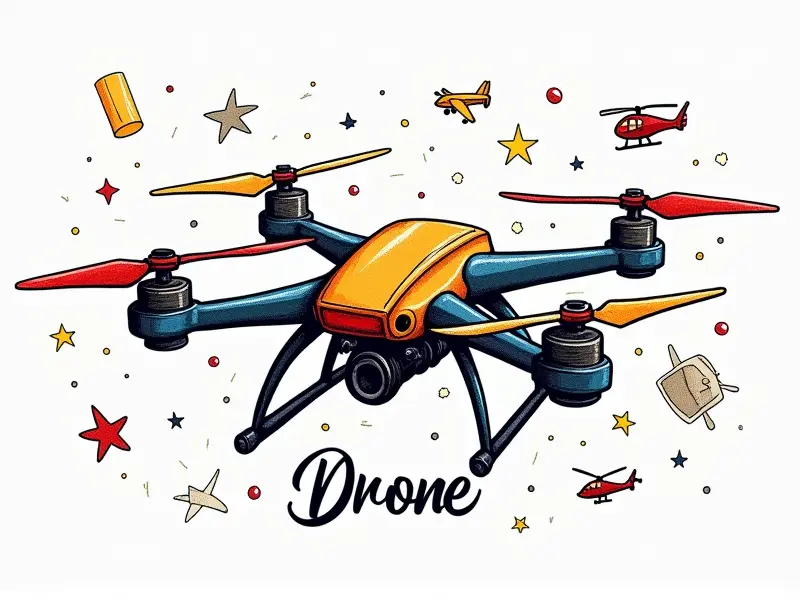What is a gimbal for FPV?

Why Use a Gimbal with Your FPV Drone?
FPV (First Person View) drones are increasingly popular among enthusiasts and professionals alike. A gimbal, specifically designed for FPV applications, enhances the drone's performance by stabilizing the camera and ensuring smooth video transmission. By reducing vibrations and providing stable footage, gimbals significantly improve the viewing experience for pilots.
Understanding FPV Gimbals Explained
An FPV gimbal is a mechanical device that holds and rotates an FPV camera to maintain its orientation relative to gravity or another reference frame. It typically consists of three axes (roll, pitch, yaw) that work together to counteract the drone's movements and provide stable footage.
How Do Gimbals Work?
- Sensors: Accelerometers and gyroscopes detect movement along each axis.
- Motors: Small motors adjust the camera position to counteract detected movements.
- Control Circuitry: A microcontroller processes sensor data and sends commands to the motors.
How to Choose the Right FPV Gimbal
Selecting the right gimbal for your FPV drone involves considering several factors:
- Size and Weight: Ensure the gimbal fits within your drone's payload capacity.
- Battery Life: Look for gimbals with efficient power consumption to extend flight time.
- Compatibility: Verify that the gimbal is compatible with your chosen camera and transmitter.
- Mounting Options: Check if the gimbal offers flexible mounting options suitable for your drone frame.
Top 3 Benefits of Using a Gimbal in FPV
Gimbals offer numerous advantages that enhance the overall experience of flying an FPV drone. Here are three key benefits:
- Stable Footage: Gimbals provide smooth, stable video transmission, making it easier to navigate and enjoy the flight.
- Better Visibility: By reducing vibrations and jitters, gimbals improve visibility during high-speed maneuvers or complex aerial shots.
- Enhanced Control: Stable footage allows pilots to focus more on flying rather than compensating for camera shake.
Maximizing Camera Quality with FPV Gimbals
To get the most out of your FPV gimbal, consider these tips:
- Calibration: Properly calibrate the gimbal to ensure accurate stabilization.
- Tuning Settings: Adjust settings like PIDs (Proportional-Integral-Derivative) for optimal performance.
- Maintenance: Regularly inspect and clean your gimbal to prevent wear and tear.
FPV Racing vs. Cinematic: Gimbal Impact Explained
The impact of gimbals varies depending on the type of FPV activity:
- FPV Racing: Gimbals are less critical in racing scenarios where quick reflexes and maneuverability take precedence.
- Cinematic Flying: For capturing high-quality aerial footage, gimbals play a crucial role in delivering smooth, professional-looking videos.
The Role of Gimbals in FPV Racing
In FPV racing, the primary focus is on speed and agility. While gimbals are not as essential for racing drones due to their high-speed nature, they can still offer benefits such as:
- Improved Visibility: Slight stabilization helps pilots maintain better visibility during fast turns.
- Post-Processing Quality: Even in racing scenarios, a stabilized video feed can enhance post-flight analysis and editing.
Beginner's Guide to FPV Drone Gimbals
If you're new to FPV drones and gimbals, here are some essential tips for getting started:
- Understand Basic Concepts: Familiarize yourself with the basics of FPV technology and drone mechanics.
- Select a Suitable Gimbal: Choose a gimbal that suits your specific needs and budget, considering factors like size, weight, and compatibility.
- Practice Calibration: Regularly calibrate your gimbal to ensure it operates smoothly and efficiently.
Essential Guide to FPV Camera Gimbals
When selecting an FPV camera gimbal, consider these key aspects:
- Camera Compatibility: Ensure the gimbal is compatible with your chosen camera model.
- Battery Efficiency: Opt for gimbals that consume less power to extend flight duration.
- User Reviews and Ratings: Check user reviews and ratings to gauge performance and reliability.
Maximizing Video Quality with FPV Gimbals
To achieve the highest video quality, follow these best practices:
- Optimize Settings: Fine-tune your gimbal's settings for optimal stabilization and performance.
- Use High-Quality Cameras: Pair your gimbal with a high-resolution camera to capture crisp, clear footage.
- Regular Maintenance: Keep your equipment clean and well-maintained to ensure consistent performance.
Setting Up Your First FPV Gimbal
Getting started with an FPV gimbal involves several steps:
- Installation: Carefully install the gimbal on your drone according to manufacturer instructions.
- Calibration: Calibrate the gimbal to ensure it operates correctly and efficiently.
- Tuning: Adjust settings like PIDs for optimal performance during flight tests.
Conclusion
Incorporating an FPV gimbal into your drone setup can significantly enhance the quality of your footage, improve visibility, and provide a more enjoyable flying experience. Whether you're engaging in FPV racing or cinematic flying, selecting the right gimbal is crucial for achieving optimal results. By understanding how gimbals work, choosing the appropriate model, and following best practices, you can maximize the benefits of using an FPV gimbal.

